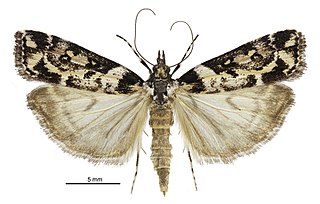
Eudonia diphtheralis is a species of moth in the family Crambidae. It is endemic to New Zealand.
Antaeotricha trichonota is a species of moth of the family Depressariidae. It is found in Brazil and Paraguay.
Antaeotricha generatrix is a moth of the family Depressariidae. It is found in Brazil.
Antaeotricha ophrysta is a moth of the family Depressariidae. It is found in Suriname.
Antaeotricha modulata is a species of moth of the family Depressariidae. It is found in Brazil, Guyana and French Guiana.
Antaeotricha ptycta is a species of moth of the family Depressariidae. It is found in Guatemala, Panama, Ecuador, the West Indies and Guyana.
Antaeotricha isochyta is a species of moth of the family Depressariidae. It is found in Guyana.
Antaeotricha thylacosaris is a species of moth of the family Depressariidae. It is found in Guyana, French Guiana and Brazil.
Antaeotricha cantharitis is a moth of the family Depressariidae. It is found in French Guiana.
Antaeotricha basalis is a species of moth of the family Depressariidae. It is found in Argentina.
Comotechna parmifera is a moth in the family Depressariidae. It was described by Edward Meyrick in 1921. It is found in Peru and Pará, Brazil.
Antaeotricha semicinerea is a moth in the family Depressariidae. It was described by Philipp Christoph Zeller in 1877. It is found in Panama, Guatemala and Brazil (Amazonas).
Antaeotricha celidotis is a moth in the family Depressariidae. It was described by Edward Meyrick in 1925. It is found in Peru.
Antaeotricha orthriopa is a species of moth in the family Depressariidae. It was described by Edward Meyrick in 1925. It is found in Brazil.
Antaeotricha sellifera is a species of moth in the family Depressariidae. It was described by Edward Meyrick in 1925. It is found in Brazil.
Antaeotricha encyclia is a species of moth in the family Depressariidae. It was described by Edward Meyrick in 1915. It is found in Colombia.
Antaeotricha euthrinca is a species of moth in the family Depressariidae. It was described by Edward Meyrick in 1915. It is found in Colombia.
Antaeotricha chilosema is a moth in the family Depressariidae. It was described by Edward Meyrick in 1918. It is found in French Guiana.
Chlamydastis discors is a moth in the family Depressariidae. It was described by Edward Meyrick in 1913. It is found in Peru.

Trachypepla protochlora is a moth of the family Oecophoridae first described by Edward Meyrick in 1883. It is endemic to New Zealand and is found in both the North and South Islands. The preferred habitat of this species is native forest and adults are on the wing from October until February. Adults can be variable in their green shaded colour as well as in the intensity of markings on their forewings. The greenish ground colouration of this moth ensures they are well camouflaged when at rest on green mosses and lichens.

